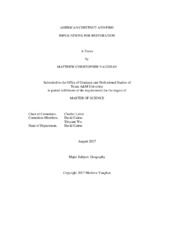| dc.description.abstract | Formerly the most dominant canopy tree species throughout much of eastern North America, the American chestnut (Castanea dentata (Marsh.) Borkh.) has since been decimated by the chestnut blight (Cryphonectria parasitica (Murr.) Barr.) and relegated to scattered understory sprouts. Providing a large, reliable seed crop and high quality timber, the American chestnut was an iconic keystone species, unrivaled in its ecological influence and economic value. Since its demise, however, continued efforts have been made to develop effective chestnut blight resistance and prepare blight-resistant chestnut hybrids for reintroduction in the wild. This project is concerned with the optimal management and habitat conditions for American chestnut within the broader goal of restoration. Does American chestnut sprout regeneration benefit from fire? How does its response to fire vary according to topography? With our incomplete understanding of chestnut fire ecology and geography, this study aims to evaluate the regeneration and distribution of American chestnut sprouts in recently burned areas of a mountainous landscape in the Ridge and Valley province of the central Appalachian Mountains in Virginia.
Transects divided into sections were selected in prescribed burn units and areas of wildfire to sample for chestnut response to fire. Observed chestnuts in sections were tallied, with the first in sight measured for additional response variables to gauge vitality: live height, number of live stems, blight infection, total stem diameter, average stem diameter, and shoot-to-root ratio. Characteristics of the fire regime and terrain (environmental variables) were then related to these response variables to determine how chestnut sprouts respond to fire and topography: burned/unburned, canopy cover proportion, number of burns, time since last burn, mean time between successive burns, Heat Load Index, Topographic Wetness Index, and Topographic Position Index. Response variables were averaged by environmental categories or correlated directly to environmental observational pairs. Various statistical tests were used for each comparison between response variable vs. environmental variable depending on the nature of the data involved.
The results of this study suggest a complex pattern of American chestnut sprout regeneration in response to fire, with some response variables more or less important in explaining the effect of each fire regime environmental variable. Among the response variables that appear to be positively related to chestnut vitality, there was no indication that increasing fire severity, occurrence, and/or frequency was a detriment to chestnut vitality. Conversely, there was no indication that increasing fire severity, occurrence, and/or frequency reduced the prevalence of blight infection. There were few significant relationships between chestnut vitality and the DEM-derived GIS terrain variables, suggesting that chestnut is well adapted to a variety of slope positions and environmental conditions. Ultimately, American chestnut vitality in early stages of growth is strongly controlled by light availability, and fire can be an important component of restoration. | en |


